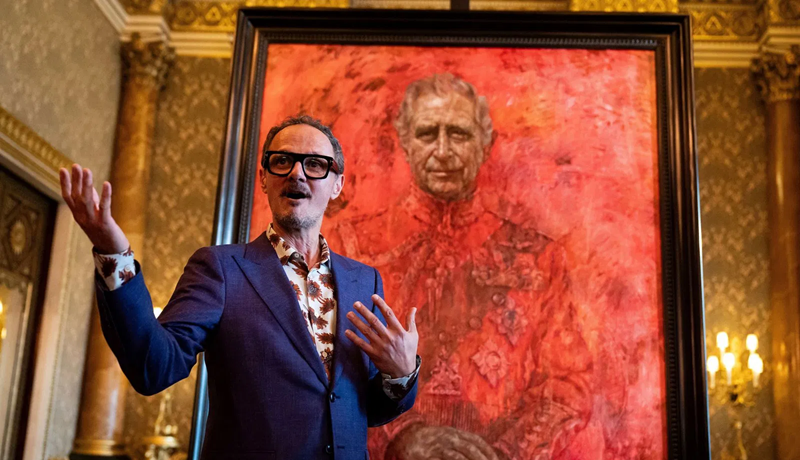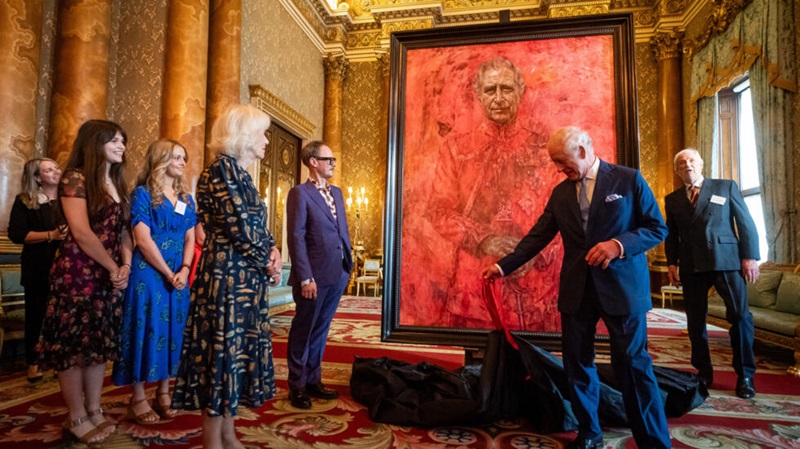The unveiling of the first official portrait of King Charles since his coronation was an event that captured the attention of the entire nation. This grand unveiling was a significant event, marking a momentous milestone in his reign. The portrait, a magnificent piece of art, beautifully captures the essence of the King’s character, portraying him with an air of regal serenity, strength, and wisdom.
The artist, celebrated for his brilliant works, has managed to encapsulate King Charles’ unique blend of grace and power, reflective of a ruler who has dedicated his life to the service of his people. Every detail in the portrait, from the meticulously painted royal robes to the finely detailed royal insignia, speaks volumes about the majesty and dignity associated with his position. The king’s expression, a mix of calm resolve and deep contemplation, provides a glimpse into his strong determination and commitment to his duties.
The backdrop of the portrait, a beautifully depicted royal palace, signifies the grandeur and magnificence of his reign. This unveiling, which was attended by distinguished guests from all walks of life, was a testament to the respect and admiration that King Charles commands among his subjects. It was not just the unveiling of a portrait, but also a celebration of a king whose reign has been marked by great dedication, commitment, and an unwavering sense of responsibility towards his people.
This portrait is not merely a representation of King Charles, but a testament to his regal presence, a symbol of his reign, and a tribute to a king who has tirelessly worked towards the betterment of his kingdom. The unveiling of the official portrait, therefore, was much more than a ceremonial event. It was a historical moment, a tribute to a man of remarkable strength and resilience, and a celebration of a reign that has left an indelible mark in the annals of history.
A New Era Captured: The First Official Portrait of King Charles
The unveiling of the first official portrait of King Charles ushered in a new era, an epoch that radiates a fresh perspective and illuminates the dawn of his reign. This significant event has been etched in the annals of history, not merely for its aesthetic appeal but also for the profound message it conveys. The portrait depicts King Charles in a resplendent royal robe, his gaze exuding an aura of resilience and determination. His countenance reflects an amalgamation of wisdom acquired from his predecessors and a novel vision for his kingdom’s future. Each brush stroke is a testament to his leadership and reveals his commitment to his people’s welfare and progress.
The artist behind the masterpiece has skillfully captured the essence of King Charles’s persona, highlighting his sense of responsibility and the gravity of his new role. The portrait, painted with intricate detail, vividly portrays the King’s inherent nobility and hints at his readiness to embrace the challenges of his reign. Every nuance, from the gentle creases on his forehead to the firm grip on his scepter, speaks volumes about his devotion to his duty.
King Charles’s first official portrait thus marks the commencement of a new chapter in the monarchy’s history. It is a perfect blend of tradition and modernity, reflecting the King’s respect for the past and his vision for the future. This innovative depiction of royalty does not merely immortalize King Charles in a frame but also establishes his image in the hearts of his subjects. It serves as a constant reminder of the monarch’s pledge to serve his people and his determination to lead them towards a prosperous future. The unveiling of the portrait was indeed a historic moment, capturing the dawn of King Charles’s reign and signifying the advent of a new era in the kingdom.

The Artist Behind the Portrait: Jonathan Yeo’s Unique Vision
Jonathan Yeo, a renowned British artist, has carved a unique niche for himself in the world of portraiture. His distinct vision has been celebrated globally, with his works adorning the walls of many prestigious galleries. Yeo’s approach to portraiture is far from traditional; he is known for his innovative use of materials and technique, often incorporating unconventional elements such as surgical sutures or collage made from pornographic magazines. This audacious experimentation turns each portrait into a rich tapestry of symbolic meaning, an exploration of the subject’s identity beyond their physical appearance.
Yeo’s subject choice is often as daring as his technique. He has painted celebrities, politicians, and royalty, but his works go beyond mere representation. Yeo seeks to explore the complex layers that constitute his subjects. His portraits of Tony Blair and David Cameron, for example, are not just depictions of the two politicians. They are a deep dive into their personalities, revealing a side of them that the public rarely gets to see.
Yeo’s vision is characterized by a fascination with the human face and a quest to unravel the stories that lie beneath the surface. His portraits are never static or lifeless; they pulsate with life, emotion, and depth. They not only capture the likeness of the subjects but also their character, their inner world, and their essence. This is perhaps what sets Yeo apart from other portrait artists – his ability to expose and celebrate the human spirit in his works.
In a world where portraiture can often be reduced to superficial likeness, Jonathan Yeo’s unique vision breathes fresh life into the genre. His daring approach, coupled with his exceptional artistic talent, makes him one of the most exciting and influential portrait artists of our time. Through his work, Yeo continues to push the boundaries of what portraiture can be, challenging our perceptions and encouraging us to see beyond the surface.
Portrait Details: What to Look for in King Charles’s New Portrait
Examining King Charles’s new portrait, there are several intricate details to notice that contribute to its overall grandeur and sophistication. The first element to grab your attention is likely the striking realism of the king’s face. The artist has crafted each feature with meticulous precision, capturing the intensity of the king’s gaze and the subtle nuances of his expressions. The vividness of the colours employed breathes life into his countenance, making him appear almost lifelike.
Next, pay attention to the portrayal of his regal attire. The artist has taken great pains to depict the intricate designs and rich textures of the royal garments, giving them a sense of depth and authenticity. The gleaming jewels adorning the king’s attire have been painted with a delicate touch, making them shimmer in the light. The careful detailing of the delicate lace collar and cuffs, as well as the intricate embroidery on his coat, speak volumes about the artist’s expertise and attention to detail.
The background of the portrait is equally noteworthy. The artist has chosen to depict a majestic palace setting, complete with towering columns and intricate carvings. This not only adds to the overall royal ambiance but also gives a sense of depth and dimension to the portrait.
Take note of the king’s stance and posture. The artist has portrayed him in a dignified and commanding pose, further emphasizing his royal stature. The use of light and shadow is masterfully done, enhancing the sense of realism and depth in the portrait. The artist’s choice of hues, the composition, and the perspective all work together to create a powerful visual narrative of King Charles’s reign, making this portrait a magnificent testament to his royal legacy.
In conclusion, the new portrait of King Charles is a marvel of artistic skill and historical significance. Its intricate details, realistic portrayal, and masterful use of colour and light make it a compelling representation of the king’s majesty and power. Whether you are an art enthusiast, a history buff, or simply an admirer of royal portraiture, this new portrait of King Charles is sure to captivate your interest.

The Significance of Royal Portraits: Historical Context and Modern Interpretations
Royal portraits hold significant historical and cultural value, serving as tangible symbols of power, wealth, and influence. They offer an intriguing glimpse into the past, into the reign of kings, queens, emperors, and empresses, capturing not just the likeness of these prominent figures, but also the socio-political context of their times. Often, these portraits were commissioned to project an image of authority, status, and grandeur, carefully constructed through lavish clothing, regal postures, and symbolic elements. In doing so, they provide a rich resource for historians and art scholars to study the reign, personality, and public image of the rulers they depict.
In modern times, these royal portraits continue to be interpreted and reinterpreted, both within and outside their historical contexts. They stimulate discussions around the power dynamics, cultural norms, and societal values of the times they represent. These interpretations can range from literal readings of the physical attributes and symbolic elements to more abstract, analytical evaluations of what these portraits reveal about the depicted ruler’s reign and legacy.
Moreover, in the contemporary art world, royal portraits often inspire reinterpretations, parodies, and critiques, serving as a medium for artists to comment on historical events or to challenge established narratives. For instance, many modern artists use these regal images to explore themes of identity, gender, representation, and power, contributing to an ongoing dialogue between the past and the present.
In museums and galleries, royal portraits continue to attract viewers, their timeless allure rooted in their historical significance, artistic mastery, and their capacity to provoke thought and discussion. Importantly, they also serve as a reminder of our shared cultural heritage, a link that connects us to the past, and a mirror that reflects our evolving understanding of history, society, and art.

Public Access: Where to View the Portrait
Public access to view the portrait is often made possible through various avenues, each providing a unique experience for the viewer. Museums, galleries, and exhibitions are some of the most common places where one can appreciate the beauty of portrait art. These institutions often have a vast collection of portraits, showcasing the work of different artists from different periods. The surroundings and atmosphere within these places also enhance the experience of viewing the art, allowing one to fully immerse themselves in the beauty and meaning behind each portrait.
Another platform that has made viewing portraits more accessible is the internet. Many museums and galleries have digitized their collections, enabling individuals from all over the world to view their collection online. This has significantly increased public access to view portraits, especially for those who cannot physically visit these institutions. In addition, social media platforms have become a popular platform for artists to showcase their work. This has allowed for a more diverse range of portraits to be viewed, as artists from all over the world can share their work with a global audience.
Public libraries also offer an avenue to view portraits. This often includes portraits of historical figures or those significant to the local community. These portraits can provide educational value, by teaching about the history and culture of the community.
Art festivals and street fairs also often display portraits. These events provide a unique opportunity to view these works in a more casual and relaxed environment. Additionally, public art installations in cities often feature portraits. These installations provide the public with free access to view the art and often aim to beautify the city and promote local culture.
In conclusion, there are numerous places where one can view a portrait. Whether it be in a museum, online, in a library, or at a festival, each provides a unique opportunity to appreciate the beauty and meaning behind each portrait.
